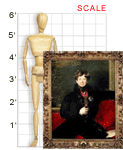VAM galleries including this work:
The Owensboro Museum of Fine Art | Seeing Red | What’s the Point? || VAM Home
Sir Thomas Lawrence (English, 1762-1830)
PORTRAIT OF GEORGE IV, c. 1820/1830
Oil on canvas; 49-1/2" X 39-1/2"
A Gift of Mr. and Mrs. Marshall S. Burlew
Collection of Owensboro Museum of Fine Art
George IV (1762-1830), the oldest son of George III, ascended to the throne of England in 1820 and ruled until his death in 1830. This portrait by Sir Thomas Lawrence provided a missing link in the mystery of the Hope Diamond, one of the world’s best-known gemstones (now housed at the Smithsonian Institution in Washington, DC). Until the early 1990s, there was a 27-year-gap in the history of the diamond, with the years 1812 to 1839 unaccounted for. After viewing this portrait, a Smithsonian research assistant suggested that King George IV wore the Hope Diamond as part of the Orders of the Golden Fleece and the Garter (royal medallions). The research was documented and published in Lapidary Journal.
About the Artist
Sir Thomas Lawrence had a notable career as a portraitist, leading to an appointment as Painter in Ordinary to the King in 1792, a knighthood in 1815, and election to the presidency of the Royal Academy in 1822. He was born on April 13, 1769 in Bristol, England, and began showing artistic inclinations at an early age. His father, an innkeeper, recognized his son’s innate talent with a pencil and began offering the child’s services for spontaneous portrait sketches to various travelers.
An excellent draftsman, Lawrence believed an accurate under-drawing to be the foundation for any successful painting. A number of his studies, rendered in pencil and black, red, or white chalk, and some with watercolor embellishments, have been preserved. They reveal the same sensitivity to form and character that is expressed in his completed oil paintings. Lawrence found painting more challenging than drawing, and the struggle to achieve harmonious tones and unifying lines in paint fully engaged him, launching him on a lifelong exploration of technique and artistic growth that ended only with his death on January 7, 1830.
Drawings and paintings by Sir Thomas Lawrence are found in the United States at such institutions as the Metropolitan Museum of Art in New York, the Los Angeles County Museum of Art, the Art Institute of Chicago, and the National Gallery of Art in Washington, DC. European institutions with his works include the British Museum, the National Gallery of Ireland, the National Gallery of Scotland, and Musée du Louvre in Paris.
Classroom Ideas
Discussion: Vocabulary related to this work includes realism and portrait. From looking at this portrait, what kind of person does George IV seem to be? If you didn’t know before seeing the painting, would you think he was royalty? Compare this portrait to other portraits in the Virtual Art Museum. What do they have in common? How do they differ?
Links
See and read about another Lawrence painting of George IV in a feature story from England’s Guardian Newspapers.
[www.guardian.co.uk/arts/portrait/story/0%2C11109%2C740379%2C00.html]
Learn more about the history of the Hope Diamond in the Encyclopedia Smithsonian.
[www.si.edu/resource/faq/nmnh/hope.htm]

